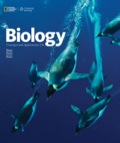
Concept explainers
Introduction:
All the organisms present in the environment is composed of a cell. The organisms are classified into two types. These are prokaryotes and eukaryotes. Prokaryotes are the organisms that do not contain a well-defined nucleus. However, eukaryotes have a well-defined nucleus properly enclosed in a nuclear membrane. A
Answer to Problem 1SQ
Correct answer:
All the fungi are heterotrophs as they depend on other organisms for food. They are not capable of producing their own food. Hence, the correct answer is option c.
Explanation of Solution
Reason for correct answer:
Option c. is given as “are heterotrophs.”
The organisms that are capable of preparing their food by the process of photosynthesis are termed as autotrophs. However, the organisms that cannot prepare food and depend on other organisms are termed as heterotrophs. Fungus is also a heterotroph as it depends on other organisms for food.
Reason for incorrect answer:
Option a. is given as, “are multicelled.”
The organisms that contain one cell are called unicellular or single-celled organisms. However, the ones that are composed of more than one cell are called multicelled organisms. Fungi can be both single-celled and multicelled. The fungi with one cell are called yeasts. Hence, option a. is incorrect.
Option b. is given as, “form flagellated spores.”
Fungi have the ability to produce spores. They can produce a variety of spores such as both flagellated and non-flagellated spores. Chyratids is the only type of fungi that produce flagellated spores. However, all other types of fungi produce non-flagellated spores. Hence, option b. is incorrect.
Option d. is given as, “all of the above.”
The only correct option that holds correct for fungi is option c. This is because fungi are heterotrophic organisms as they cannot prepare their own food. However, all the other options do not explain the characteristic of fungi accurately. Hence, option d. is incorrect.
Hence, the options a., b., and d. are incorrect.
Fungi are the heterotrophic organisms as they cannot prepare food. They are dependent on other organisms for their nutrition. Thus, the correct option is c.
Want to see more full solutions like this?
Chapter 22 Solutions
EBK BIOLOGY: CONCEPTS AND APPLICATIONS
- What is behavioral adaptarrow_forward22. Which of the following mutant proteins is expected to have a dominant negative effect when over- expressed in normal cells? a. mutant PI3-kinase that lacks the SH2 domain but retains the kinase function b. mutant Grb2 protein that cannot bind to RTK c. mutant RTK that lacks the extracellular domain d. mutant PDK that has the PH domain but lost the kinase function e. all of the abovearrow_forwardWhat is the label ?arrow_forward
- Can you described the image? Can you explain the question as well their answer and how to get to an answer to an problem like this?arrow_forwardglg 112 mid unit assignment Identifying melting processesarrow_forwardGive only the mode of inheritance consistent with all three pedigrees and only two reasons that support this, nothing more, (it shouldn't take too long)arrow_forward
- Oarrow_forwardDescribe the principle of homeostasis.arrow_forwardExplain how the hormones of the glands listed below travel around the body to target organs and tissues : Pituitary gland Hypothalamus Thyroid Parathyroid Adrenal Pineal Pancreas(islets of langerhans) Gonads (testes and ovaries) Placentaarrow_forward

 Biology: The Dynamic Science (MindTap Course List)BiologyISBN:9781305389892Author:Peter J. Russell, Paul E. Hertz, Beverly McMillanPublisher:Cengage Learning
Biology: The Dynamic Science (MindTap Course List)BiologyISBN:9781305389892Author:Peter J. Russell, Paul E. Hertz, Beverly McMillanPublisher:Cengage Learning Biology (MindTap Course List)BiologyISBN:9781337392938Author:Eldra Solomon, Charles Martin, Diana W. Martin, Linda R. BergPublisher:Cengage Learning
Biology (MindTap Course List)BiologyISBN:9781337392938Author:Eldra Solomon, Charles Martin, Diana W. Martin, Linda R. BergPublisher:Cengage Learning Concepts of BiologyBiologyISBN:9781938168116Author:Samantha Fowler, Rebecca Roush, James WisePublisher:OpenStax College
Concepts of BiologyBiologyISBN:9781938168116Author:Samantha Fowler, Rebecca Roush, James WisePublisher:OpenStax College Biology Today and Tomorrow without Physiology (Mi...BiologyISBN:9781305117396Author:Cecie Starr, Christine Evers, Lisa StarrPublisher:Cengage Learning
Biology Today and Tomorrow without Physiology (Mi...BiologyISBN:9781305117396Author:Cecie Starr, Christine Evers, Lisa StarrPublisher:Cengage Learning Biology: The Unity and Diversity of Life (MindTap...BiologyISBN:9781305073951Author:Cecie Starr, Ralph Taggart, Christine Evers, Lisa StarrPublisher:Cengage Learning
Biology: The Unity and Diversity of Life (MindTap...BiologyISBN:9781305073951Author:Cecie Starr, Ralph Taggart, Christine Evers, Lisa StarrPublisher:Cengage Learning





